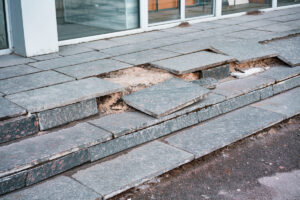
Whether it’s photographic evidence of the hazardous condition, eyewitness statements, or maintenance records, evidence plays a pivotal role in demonstrating the property owner’s liability. Knowing what evidence to gather – and how it may support your case – can significantly impact a favorable outcome. The lawyers of Goza & Honnold can handle all aspects of your premises liability claim while you focus on recovery.
7 Types of Evidence Used in a Premises Liability Claim
A successful premises liability claim hinges on proving that the property owner’s negligence led to injury. Gathering evidence is essential to establish the property owner’s responsibility and your entitlement to compensation. The following is a breakdown of the key types of evidence used in these claims:
1. Photographic and Video Evidence
Images and videos are powerful tools in premises liability cases. They can clearly depict the hazardous condition that caused the injury at the time it occurred. This might include wet floors without warning signs, uneven sidewalks, or poor lighting. Always try to capture the condition as soon as the incident happens before any changes can be made.
2. Accident Reports
If the injury occurred in a business or public setting, there might be an accident report filed by the property manager or owner. This report can provide an official account of the incident and may include details about the conditions leading up to the injury.
3. Witness Statements
Testimonies from people who witnessed the accident or who can attest to the ongoing unsafe condition can significantly strengthen your case. Witness statements help corroborate your account of the incident and can provide additional context about the environment and the property owner’s negligence.
4. Medical Records
Medical records not only establish the extent and nature of the injuries but also link them directly to the accident. These records are crucial for quantifying damages in terms of medical expenses and the impact on your quality of life.
5. Maintenance Records
These can demonstrate whether the property owner performed regular upkeep and safety checks. Improper or lack of maintenance or failure to address known hazards can be strong indicators of negligence.
6. Property Inspections
Professional inspections or expert testimonies regarding the property’s condition can provide an authoritative perspective on the standard of care maintained by the property owner compared to what is reasonably expected.
7. Historical Complaints
Records of previous complaints about similar issues or past incidents at the same location can further show the property owner was aware of the hazard but failed to remedy it, thereby establishing a pattern of negligence.
Each piece of evidence serves to build a comprehensive picture of the circumstances leading to the injury and helps in proving the liability of the property owner.
Damages You Can Recover in a Successful Premises Liability Claim
When you successfully prove a premises liability claim, you may recover various types of damages that compensate you for the losses you have suffered. These damages are generally categorized into economic and non-economic depending on the severity and circumstances of the case.
- Medical Expenses: These cover all health-related costs resulting from the injury, including hospital stays, medical treatments, surgeries, medications, physical therapy, and future medical care.
- Lost Wages and Earning Capacity: If your injuries force you to miss work, you can claim compensation for lost wages. Furthermore, if your injuries impair your ability to earn money in the future, you may also be eligible for damages covering loss of earning capacity.
- Pain and Suffering: This category compensates you for the physical pain and emotional distress caused by the injuries. The amount can vary widely as it is subjective and depends on the severity of the pain and the duration of recovery.
- Loss of Quality of Life: If the injuries result in a long-term impact on your lifestyle, such as disabilities that prevent you from doing activities you once enjoyed, you may receive compensation for loss of quality of life.
- Emotional Distress: Separate from pain and suffering, these damages compensate for psychological trauma such as anxiety, depression, and PTSD, which are common after traumatic incidents.
Successfully claiming these damages typically requires a detailed and well-documented case that clearly links the injuries and losses to the negligence encountered on the property. The personal injury lawyers of Goza & Honnold provide invaluable guidance in navigating the legal process, ensuring that all potential damages are accounted for and maximized.
Speak With the Premises Liability Lawyers of Goza & Honnold
If you suffered injuries on someone’s property due to negligence, you may have legal options to pursue compensation. The lawyers of Goza & Honnold can provide the guidance and support you need to navigate the complexities of your claim, including conducting an investigation into the incident and gathering necessary evidence.
Speak with one of our Missouri premises liability lawyers to discuss your case by calling (913) 451-3433 or fill out a contact form.

Goza & Honnold, a trusted personal injury law firm serving Missouri and Kansas, is known for our dedication to client advocacy and trial excellence. With a strong focus on auto accidents, medical negligence, and product liability cases, our experienced attorneys work diligently to secure fair outcomes while being fully prepared to take cases to trial when necessary. We work closely with our clients to build strong cases that reflect their unique experiences.
